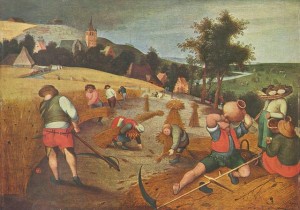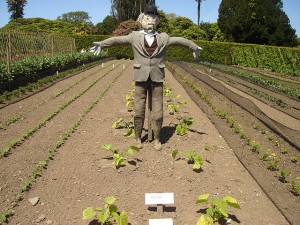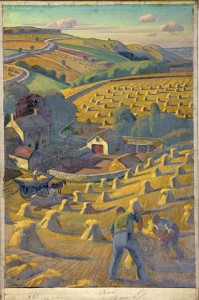Autumn officially began with the Equinox on September 23, when the hours of darkness and light were almost equal. As we move forward in the northern hemisphere, the days become shorter and the nights, longer. It is a time of gloom and the early stages of Seasonal Affective Disorder.
The word Autumn is a French derivative that entered English in the 16th Century. Before that, this transitional season was called Harvest. If the harvest was good, it was time to celebrate.

After the crops are in, scarecrows appear. As the name implies, scarecrows are supposed to frighten birds away from young crops in the spring. After their job is over, the figures are burned and the ash left to replenish the soil.

Scarecrows of some sort have been in use as long as farmers planted fields in the spring. Once the seedlings are up, the birds appear. A flock of crows can quickly destroy the crops. Hence the need to frighten them away.
In medieval Britian, the job went to boys who patrolled the fields with a bag of stones. When the birds landed, the boys chased them and threw the rocks. After the Great Plague of 1349, there weren’t enough boys. Each child patrolled up to three acres. The stones were too heavy to carry, so the children used clappers instead.
To keep the birds at bay while the boys were busy elsewhere, farmers stuffed sacks with straw and hung them on poles. They used animal skulls, rotting fruit, or carved gourds as heads.

American traditions spring from German immigrants in Pennsylvania who built a scarecrow called a bootzaman, or bogeyman. These inanimate workers stuffed with straw often wore old overalls and a long sleeved shirt or coat.
After World War II, farmers decided scarecrows were inefficient, and the stuffed helper retired to become a seasonal symbol. I suspect the straw people “enjoy” their annual celebrity.
Acknowledgements:
Featured Image: Autumn Leaves. Photo by Jean-Pol Grandmont. Creative Commons Attribution. Wikimedia Commons.
Scarecrow at Lost Gardens of Heligan by Northmetpit. Creative Commons Attribution. Wikimedia Commons.
Der Sommer by Abel Grimmer (1585-1630). Public Domain. Wikimedia Commons.
Harvesting by Adrian Allison (1890-1959). Public Domain. Wikimedia Commons.
History of Scarecrows. Here.
Lori Rotenberk. “Hay, Man: The Curious Life and Times of Scarecrows.” Modern Farmer. May 28, 2014. Here.
Forrest Wickman. “Why is Autumn the Only Season with Two Names?” Slate. Sept 23, 2015. Here.

Sandra Wagner-Wright holds the doctoral degree in history and taught women’s and global history at the University of Hawai`i. Sandra travels for her research, most recently to Salem, Massachusetts, the setting of her new Salem Stories series. She also enjoys traveling for new experiences. Recent trips include Antarctica and a river cruise on the Rhine from Amsterdam to Basel.
Sandra particularly likes writing about strong women who make a difference. She lives in Hilo, Hawai`i with her family and writes a blog relating to history, travel, and the idiosyncrasies of life.

